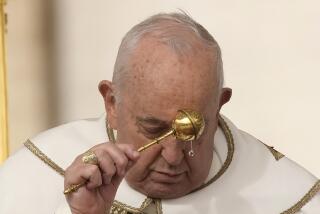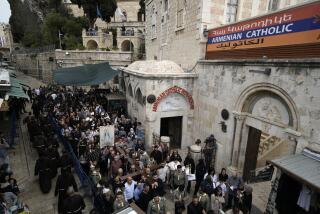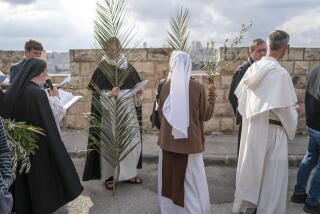John Paul Enters Israel After Visit to Jordan River
- Share via
JERUSALEM — Pope John Paul II began the first official papal visit to Israel on Tuesday after sidestepping a new Holy Land dispute as seemingly intractable as the ancient religious and political conflicts he faces this week as a guest of both the Israeli and Palestinian leaderships.
The pontiff came to a spring by the Jordan River that is at the heart of a modern-day debate about something as old as Christianity itself: Where exactly was Jesus baptized?
For the record:
12:00 a.m. March 29, 2000 For the Record
Los Angeles Times Wednesday March 29, 2000 Home Edition Part A Page 3 Metro Desk 1 inches; 23 words Type of Material: Correction
Papal trip--A March 22 story on Pope John Paul II’s trip to the Middle East should have made reference to the Gospel of John in the New Testament, not the Old Testament.
Dipping an olive branch into a tray of blessed spring water, he shook it three times at a crowd of several thousand worshipers in a wind-swept gorge and read a prayer about the power of the 2,000-year-old baptismal rite. It was a deceptively simple event, his last in Jordan on a weeklong Holy Land pilgrimage that began Monday.
Jordan’s government thought that it had scored a coup by getting the pope to visit the East Bank site--Wadi al Kharrar, or Valley of the Trickling Water--which it recently began touting as the spot where John the Baptist baptized the adult Jesus at the start of his public ministry.
But last week, Palestinian Authority President Yasser Arafat persuaded the Vatican to add to the pope’s long-planned itinerary a rival baptismal site in the West Bank--one revered by Christian pilgrims for more than a millennium and now promoted by Arafat and Israeli leaders. The pope is to visit that site today.
So far, the cross-river rivalry is tame by comparison with other Middle Eastern conflicts. But the region’s Roman Catholic patriarch, Michel Sabbah, warned last week that the dispute, with millions of dollars in annual tourism income at stake, “could tear apart the Jordanian and Palestinian peoples.”
At the spring Tuesday, the pope maintained the Vatican’s neutrality, merely noting that “both banks are visited by hosts of pilgrims honoring the baptism of the Lord.”
But as Jordan’s tourism minister guided the pope around the dusty site, Jordanian television commentators explained with confidence that all evidence backs Jordan’s claim.
John Paul is touring 15 Holy Land venues connected to what he calls “the history of our salvation,” using them as props for teaching reconciliation among the region’s Christians, Jews and Muslims. Recounting biblical passages about Abraham, Moses, John the Baptist and Jesus, he asked 30,000 worshipers at a morning Mass in Amman, the Jordanian capital, to contemplate “the origins of our faith” while reaching out to believers of “the other great religions which flourish here.”
Landing at Tel Aviv’s Ben Gurion International Airport, John Paul said, “We all know how urgent is the need for peace and justice, not for Israel alone but for the entire region.” To that end, he added, “Christians and Jews together must make courageous efforts to remove all forms of prejudice” toward each other.
Prime Minister Ehud Barak, President Ezer Weizman and nearly the entire Israeli Cabinet greeted the pope, a signal of the tremendous importance Israel attaches to his visit.
Weizman, Israel’s largely ceremonial head of state, welcomed John Paul in Hebrew, expressing gratitude for the pope’s long record of condemning anti-Semitism.
The 75-year-old president also seized the moment to raise one of the most sensitive issues facing the pope during his six days here: the status of Jerusalem, which Israel describes as its eternal capital and the Palestinians claim as the capital of their own longed-for state.
Before the pope flew with his entourage by helicopter to the disputed city, Weizman described Jerusalem as a “city of peace,” sacred to the world’s three great monotheistic religions but also the “very heart of the Jewish people” and their eternal city.
The dispute over Jesus’ baptism, by contrast, has Israel and the Palestinian Authority on the same side--eager to blunt Jordan’s belated claim to possessing the “real” site.
The two sites are just a few miles apart, at a point where the Jordan is a muddy stream. Archeologists at both sites have found remains of ancient Christian churches and monasteries and believe that they might have been built to commemorate Jesus’ baptism.
The West Bank site, known in Arabic as Kasar al Yehud, or the Jewish Palace, is on land Israel captured and has held since the 1967 Middle East War but not far from the Palestinian-governed city of Jericho. So eager were Israelis and Palestinians to draw the pope there that they abandoned a game of brinkmanship over which side would accompany him. He will go without official escort, Vatican officials said.
Although the Palestinians expect to get control of the site in peace negotiations, Israel is planning to refurbish its churches and monasteries, which have crumbled during 33 years of neglect behind mines and barbed wire.
Across the river, meanwhile, the Jordanian officials have been promoting the Wadi al Kharrar site since archeologists began unearthing ancient churches and baptismal pools in 1997. The springs are more than a mile east of the river’s current bank; Tourism Minister Akel Biltaji claims that John the Baptist more likely used the springs rather than the river itself, whose currents were far stronger in those days.
To bolster their claim, the Jordanians cite the Gospel of Luke, which places John the Baptist on the east bank of the Jordan the day before Christ came to him.
“We do not need a seal,” Biltaji told the Jordan Times in a recent interview. “This is where the first Christian community on Earth emerged.”
Vatican officials planning the pope’s visit refused to take sides. Joaquin Navarro-Valls, the papal spokesman, brought the Old Testament to a Vatican briefing last week and quoted from the Gospel of John, which says that John the Baptist worked both sides of the river.
“The entire River Jordan is sacred, on its eastern bank and on its western bank, and this should unite the Palestinian and Jordanian people,” Sabbah, the Jerusalem-based Catholic patriarch, told a news conference last week in Amman. “None of the Gospels say that Christ was baptized here or there.”
More to Read
Sign up for Essential California
The most important California stories and recommendations in your inbox every morning.
You may occasionally receive promotional content from the Los Angeles Times.










